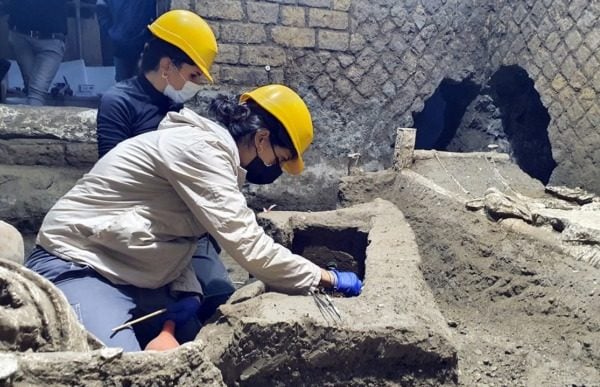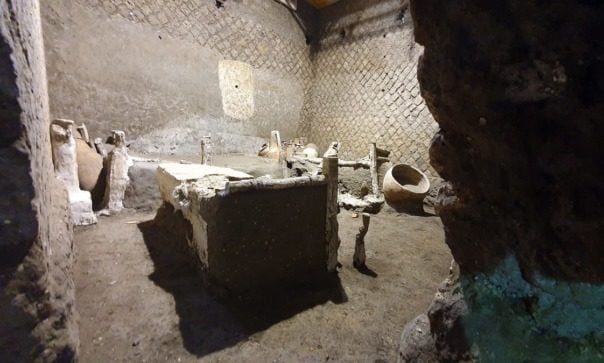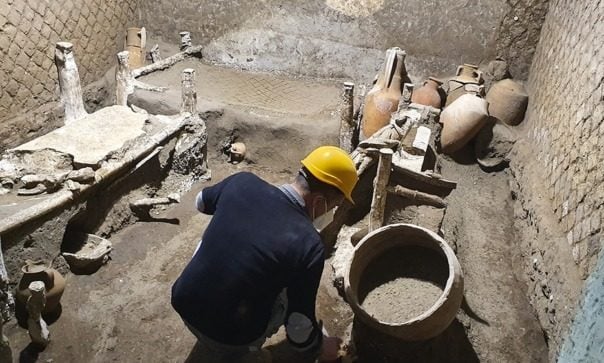This rich baker's dwelling, complete with garden, stables, mill and a sumptuous fresco of a tender kiss, stands on via dell'Abbondanza, the once-bustling thoroughfare of this ancient Roman city.
It also boasts the grinning skeletons of petrified mules caught in the 79AD eruption of Mount Vesuvius.
Visitors will be able to snatch a rare glimpse this weekend of the 1500-square metre (16,000 square foot) site.
After February 14th it will close its doors again for a four-year restoration as part of a multi-million euro Pompeii preservation project.
“The complex encapsulates both the beauty and the challenges of Pompeii,” archaeologist Alberta Mattelone, 40, told AFP.
“There is the archaeological heritage – the houses and frescoes – as well as the traces of the eruption, the volcanic deposits. Then there are the conservation problems; roofing, escarpments, preserving the frescoes,” she said.
Ghosts of mules past
The kiss decorates one of the walls of the triclinium, the small dining room where ancient Romans would have lounged on couches to eat and drink.
Whether the menu was cheese and honey or dormice, it will have been accompanied by freshly baked bread.
Next to the triclinium sits the bakery, with its stones used to ground the grain and a large oven where flat, round loaves scored across the top were prepared and sold at a little shop next door.
Just inside the shop's doorway are the scribbled running tabs of customers who still owe the baker money for bread they likely munched on with dried fruits and olives sold at the food stall opposite.
The stone mill was driven by six mules and a donkey kept in the stable – and trapped inside when the molten rock and ash hit.
“They were analysed by an archaeo-zoologist: they suffocated, all apart from one killed by a blow to the head as the building collapsed,” Mattelone said, adding that the unfortunate four-legged creatures were “in an excellent state of conservation”.
Behind the stable lies the House of the Painters at Work, where interior decorators were half-way through sprucing up a room when the volcano erupted, as well as a garden which is being re-created exactly as it was thanks to archaeo-botanists.
The complex was first explored in 1912, unveiling a balcony later damaged by Allied bombs in the Second World War.
It was not until 1982 that serious digs began. They ran until 2004 and the site opened briefly in 2010, only to close again.
'Great impact'
“We are opening it for Saint Valentine's because we wanted the public to be able to get in before we close the site to refurbish the roof and supporting structure,” said Michele Granatiero, 61, the project's head architect.
“It is an opportunity to create an architectural, structural and technological work of great impact,” he said.
Pompeii, the second most visited attraction in Italy after the Colosseum in Rome, with a record 3.2 million visitors in 2016, has been plagued in recent years by a series of collapses due to lack of maintenance and bad weather.
The rusting poles holding up the walls at the House of the Chaste Lovers will be replaced with a few external braces and dozens of underground struts.
Visitors will explore the site from a new raised walkway under an aluminium and plexiglass roof.
Those lucky enough to get in now will tour in groups of up to 20 around an enchanting area with mosaics of coloured marble, storerooms of ceramic pots and frescoes of birds, plants and one of the softest smooches of the Roman era.
By Ella Ide






 Please whitelist us to continue reading.
Please whitelist us to continue reading.
Member comments